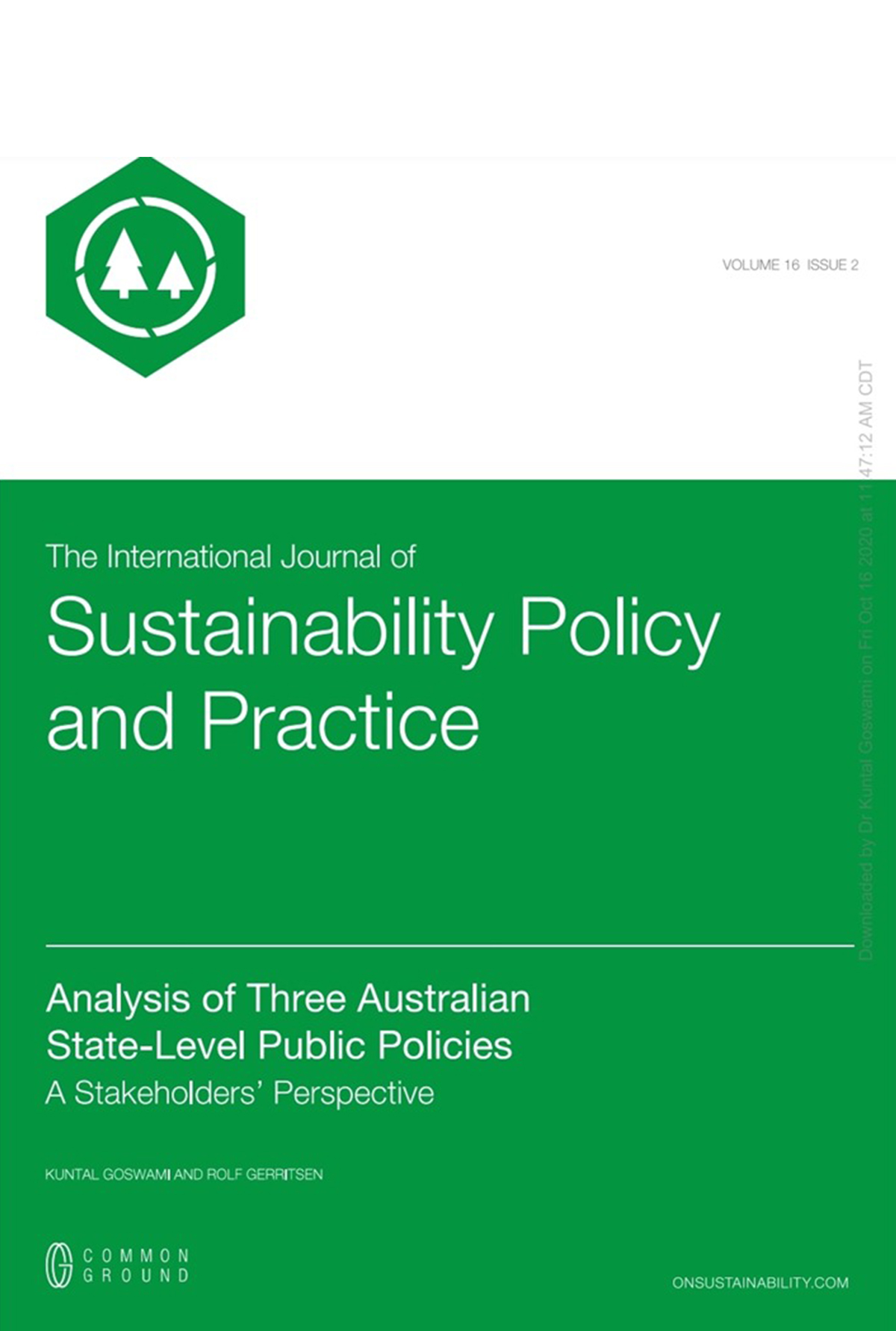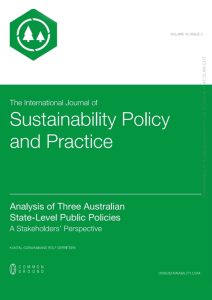Journal Articles
Analysis of Three Australian State-Level Public Policies A Stakeholders’ Perspectives
Subheading: Analysis of Australian Sustainability Policies: A Stakeholders’ Perspectives
Abstract:
This article investigates how stakeholders perceive Tasmania Together, South Australia’s Strategic Plan, and Western Australia’s State Sustainability Strategy as overarching holistic sustainability public policies. In real politics, perception matters more than reality. Hence, understanding stakeholders’ perspectives enabled us to evaluate these policies’ perceived benefits and political implications at the Australian subnational level.
In order to execute the research objectives, we conducted semi-structured, face-to-face interviews with a wide range of stakeholders (primary, secondary, and tertiary) across Tasmania, South Australia, and Western Australia. The study revealed that the socioeconomic–political discourse of a jurisdiction and the type of public policy adopted by a government are outcomes of the geoeconomic endowments of the jurisdiction.
Lastly, the study also demonstrated how a particular group of stakeholders (primary, secondary, and tertiary) can be more advantageous over other groups to understand and evaluate certain specific aspects of public policy.
Keywords: Australian Sustainability Policies, Tasmania Together, South Australia’s Strategic Plan, and Western Australia’s State Sustainability Strategy, Stakeholders’ Perspectives, Policy Evaluation, Holistic Sustainability (Economic, Environment and Social), Stakeholder Analysis, Semi-Structured Interview, Australian Subnational Public Policy Analysis
Goswami, K; & Gerritsen, R (2020), ‘Analysis of Three Australian State-Level Public Policies: A Stakeholders’ Perspective’, The International Journal of Sustainability Policy and Practice Vol.16. No.2, pp.15-39 https://doi.org/10.18848/2325-1166/CGP/v16i02/15-39
Introduction to Australian Sustainability Policies
A public policy is an ideological offspring of a political process or the governing political party. In the early 2000s, when the Australian Labor Party came to power in most Australian states, they introduced a new vision of public governance. The key theme of this new political vision was to formulate a holistic sustainability value-based strategic plan or sustainability strategy for the public sector. In addition, the key intention of this policy vision was to integrate public agencies toward collective functional efficiency.
This was contrary to the previous policy ideology that had been inspired by the New Public Management (NPM) governance model. The NPM advocates for working toward each agency’s internal goals, which is a counterproductive silo (Gallop, 2007a). The Labor Party’s new political vision—strategic planning for the public sector—was, in fact, a policy learned from the State of Oregon in the United States. In the early 1990s, the State of Oregon formulated Oregon Shines—an overarching strategic plan for the state.
Over time, the policy model organically incorporated the sustainable development concept by addressing the state’s key economic, social, and environmental challenges. Oregon’s policymakers felt that many of the state’s issues were interconnected, requiring a holistic sustainability (economic, social, and environmental) approach (Kittredge and Kissler, 1998). Oregon’s strategic planning model was structured around the sustainable development-based benchmarking system and replicated in Australian sub-national jurisdictions (Kissler et al. 1998).
When the Australian Labor Party policymakers adopted the Oregon policy model, their newly drafted strategic plans were also structured around the holistic sustainability-based benchmarking system by default. Other than the influence of Oregon Shines, Western Australia’s former Labor Party Leader, Professor Geoff Gallop—the former premier of Western Australia, and a notable academic, Professor Peter Newman – also an adviser of Professor Gallop, both acted as additional catalysts in Western Australia to adopt the State Sustainability Strategy. Both were firm believers in sustainability values.
The strategic plan-based policy experiment started in Queensland with the Beattie government’s adoption of the Smart State Plan in 1998. In 2001, the Brack-led Labor government in Victoria and the Bacon-led Labor government in Tasmania launched Growing Victoria Together and Tasmania Together in their respective states. In 2004, the Rann-led Labor government adopted South Australia’s Strategic Plan. In Western Australia, the Gallop government launched Better Planning: Better Services and the State Sustainability Strategy in 2003 (Martin and Christof 2011). Finally, New South Wales’s A New Direction for the Future was implemented in 2006 by the Iemma government (Gallop 2007b; Tagliaferri 2011).
Previous research has examined these Australian sub-national strategic plan-based public policies from various dimensions other than the stakeholders’ policy evaluation perspective. We have selected three such policies from these state-based policies as a case study. Hence, our study investigated how different stakeholder groups perceived and viewed Tasmania Together (TT), South Australia’s Strategic Plan (SASP), and Western Australia’s State Sustainability Strategy (WASSS) as examples of overarching holistic sustainability-based public policy. In addition, understanding stakeholders’ perspectives enabled us to analyze these policies’ perceived benefits and political implications at the Australian state level.
Literature Review on Sustainability Policies
Over the years, the sustainable development concept has been disseminated and accepted in many national, subnational, and local jurisdictions. This section discusses literature focusing on sustainable development–based policies at the subnational level. Marks, Hooghe, and Schakel (2008) defined the subnational level as jurisdictions between national and local levels of government. Since the late 1980s, several US state governments have launched state-based strategic planning with holistic sustainability (economic, social, and environmental) targets and benchmarks to guide public policies. In a three-tier democratic political structure, the subnational jurisdiction (usually called a state, province, or canton) has a range of policy implementation responsibilities. Since the late 1980s, many subnational jurisdictions have initiated sustainable development–based policies. However, the contents of sustainable development–based policy depend on domestic conditions (Happaerts 2012).
Happaerts and Van Den Brande (2011) pointed out major global summits on sustainable development, such as the Brundtland Commission (1987), the Rio Earth Summit (1992), and Johannesburg (2002). Conferences immensely influenced the dissemination of sustainability values.
However, the determination of political actors is also a critical factor that triggered sustainable development policies in many subnational jurisdictions. Many subnational governments showed a desire to participate in international sustainable development governance. This also led to transnational networks (Happaerts and Van Den Brande 2011).
In the 1980s, the Australian public policy–making process was guided by the NPM philosophy. Over time, the narrow focus of an “agency-centric” effectiveness approach was replaced by “whole-of-government” strategic planning processes centered around sustainable development values or holistic sustainability (economic, social, and environmental) values (Andrews and Van de Walle 2013; Considine, O’Sullivan, and Nguyen 2014; Gallop, 2007b; Johnston, 2000). With this change in public governance, many Australian state governments embraced strategic planning. They incorporated sustainability and the triple-bottom-line approach as core values within their policymaking process (Gallop 2007a, 2007b).
Between 1998 and 2006, many Australian states adopted strategic plans or strategy. Adams and Wiseman (2003) described this phenomenon as an alternative policy paradigm to withstand increasing global uncertainty. Crowley and Coffey (2007a, 2007b) called this policy experiment a new macro-policy framework and classified these policy initiatives as an apolitical bottom-up process. Nabben (2011) analyzed one of these policies as a community development tool. Manwaring (2010) claimed that although policy champions were open to community consultation processes, their efforts could have garnered public enthusiasm.
Gallop (2007a, 2007b) saw state-level strategic planning as an institutional alternative to the NPM policy model. He felt that if strategic planning were combined with the concept of sustainability, it would provide a good framework for policymaking. Althaus (2008) pointed out that all these states’ plans were a tool for managing political risks and a communication mechanism to manage government credibility. Van Schoubroeck (2008) called adopting strategic planning at the state level a new orthodoxy in the post-NPM era. McMahon and Phillimore (2013) analyzed all the state strategic plans adopted by various Australian state governments between 2001 and 2011. They showed how each state’s plan fulfilled its purposes and functions as a monitoring, managing, and marketing tool.
As mentioned above, the discussion showed literature that analyzed the public sector–based strategic plan or strategy from various points of view (an overview is presented in Table 1). However, none of the literature evaluated these policies from stakeholders’ perspectives. Stakeholders’ perspective is a vital policy evaluation tool. Therefore, we present stakeholders’ perspectives on the three selected policies: TT, SASP, and WASSS. READ MORE




